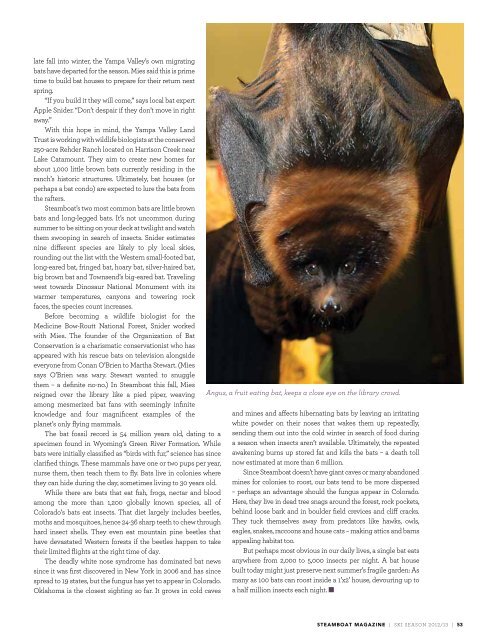Steamboat
Epic! That word is spoken enthusiastically on powder days in Steamboat. My backcountry companions say it often; we can be a bit smug about our tele excursions into unofficial terrain like Way Right, Drunken Indian, Storm King and North Woods. But the truth is, Back in the Day, Loris and Buddy Werner and their friends had truly epic ski adventures. In the 1950s, they’d drive up Rabbit Ears to the top of Hogan Park Trail… before it was a marked Forest Service route. They’d put skins over their alpine skis and break trail all the way to what is now Morningside. That’s seven miles. Once there, they’d build a snow cave, light a fire and settle in for the night.
Epic! That word is spoken enthusiastically on powder days in Steamboat. My backcountry companions say it often; we can be a bit smug about our tele excursions into unofficial terrain like Way Right, Drunken Indian, Storm King and North Woods. But the truth is, Back in the Day, Loris and Buddy Werner and their friends had truly epic ski adventures. In the 1950s, they’d drive up Rabbit Ears to the top of Hogan Park Trail… before it was a marked Forest Service route. They’d put skins over their alpine skis and break trail all the way to what is now Morningside. That’s seven miles. Once there, they’d build a snow cave, light a fire and settle in for the night.
Create successful ePaper yourself
Turn your PDF publications into a flip-book with our unique Google optimized e-Paper software.
late fall into winter, the Yampa valley’s own migrating<br />
bats have departed for the season. Mies said this is prime<br />
time to build bat houses to prepare for their return next<br />
spring.<br />
“if you build it they will come,” says local bat expert<br />
apple snider. “Don’t despair if they don’t move in right<br />
away.”<br />
With this hope in mind, the Yampa valley land<br />
Trust is working with wildlife biologists at the conserved<br />
250-acre Rehder Ranch located on Harrison creek near<br />
lake catamount. They aim to create new homes for<br />
about 1,000 little brown bats currently residing in the<br />
ranch’s historic structures. ultimately, bat houses (or<br />
perhaps a bat condo) are expected to lure the bats from<br />
the rafters.<br />
steamboat’s two most common bats are little brown<br />
bats and long-legged bats. it’s not uncommon during<br />
summer to be sitting on your deck at twilight and watch<br />
them swooping in search of insects. snider estimates<br />
nine different species are likely to ply local skies,<br />
rounding out the list with the Western small-footed bat,<br />
long-eared bat, fringed bat, hoary bat, silver-haired bat,<br />
big brown bat and Townsend’s big-eared bat. Traveling<br />
west towards Dinosaur National Monument with its<br />
warmer temperatures, canyons and towering rock<br />
faces, the species count increases.<br />
Before becoming a wildlife biologist for the<br />
Medicine Bow-Routt National Forest, snider worked<br />
with Mies. The founder of the organization of Bat<br />
conservation is a charismatic conservationist who has<br />
appeared with his rescue bats on television alongside<br />
everyone from conan o’Brien to Martha stewart. (Mies<br />
says o’Brien was wary. stewart wanted to snuggle<br />
them – a definite no-no.) in steamboat this fall, Mies<br />
reigned over the library like a pied piper, weaving<br />
among mesmerized bat fans with seemingly infinite<br />
knowledge and four magnificent examples of the<br />
planet’s only flying mammals.<br />
The bat fossil record is 54 million years old, dating to a<br />
specimen found in Wyoming’s Green River Formation. While<br />
bats were initially classified as “birds with fur,” science has since<br />
clarified things. These mammals have one or two pups per year,<br />
nurse them, then teach them to fly. Bats live in colonies where<br />
they can hide during the day, sometimes living to 30 years old.<br />
While there are bats that eat fish, frogs, nectar and blood<br />
among the more than 1,200 globally known species, all of<br />
colorado’s bats eat insects. That diet largely includes beetles,<br />
moths and mosquitoes, hence 24-36 sharp teeth to chew through<br />
hard insect shells. They even eat mountain pine beetles that<br />
have devastated Western forests if the beetles happen to take<br />
their limited flights at the right time of day.<br />
The deadly white nose syndrome has dominated bat news<br />
since it was first discovered in New York in 2006 and has since<br />
spread to 19 states, but the fungus has yet to appear in colorado.<br />
oklahoma is the closest sighting so far. it grows in cold caves<br />
Angus, a fruit eating bat, keeps a close eye on the library crowd.<br />
and mines and affects hibernating bats by leaving an irritating<br />
white powder on their noses that wakes them up repeatedly,<br />
sending them out into the cold winter in search of food during<br />
a season when insects aren’t available. ultimately, the repeated<br />
awakening burns up stored fat and kills the bats – a death toll<br />
now estimated at more than 6 million.<br />
since steamboat doesn’t have giant caves or many abandoned<br />
mines for colonies to roost, our bats tend to be more dispersed<br />
– perhaps an advantage should the fungus appear in colorado.<br />
Here, they live in dead tree snags around the forest, rock pockets,<br />
behind loose bark and in boulder field crevices and cliff cracks.<br />
They tuck themselves away from predators like hawks, owls,<br />
eagles, snakes, raccoons and house cats – making attics and barns<br />
appealing habitat too.<br />
But perhaps most obvious in our daily lives, a single bat eats<br />
anywhere from 2,000 to 5,000 insects per night. a bat house<br />
built today might just preserve next summer’s fragile garden: as<br />
many as 100 bats can roost inside a 1’x2’ house, devouring up to<br />
a half million insects each night. n<br />
STEAMBoAT MAGAZinE | SKI SEASON 2012/13 | 53

















